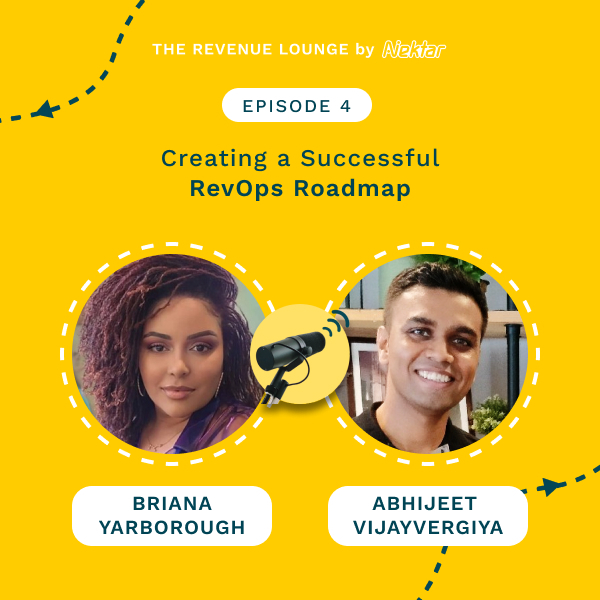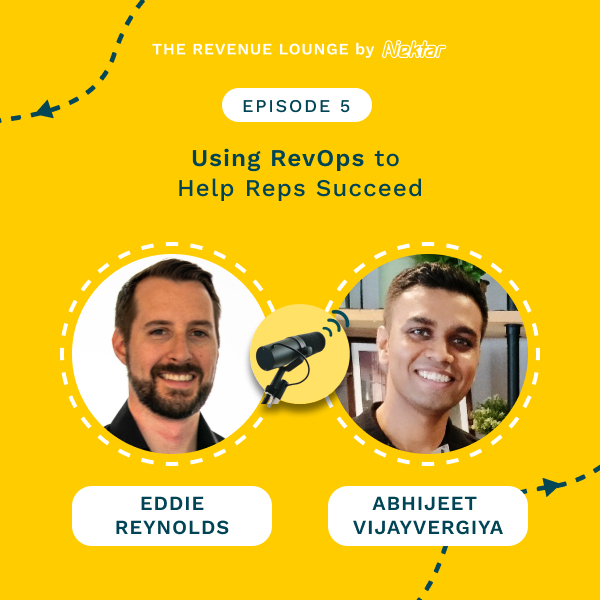Raising the Bar for RevOps Strategy and Planning ft. Dana Therrien
February 28, 2024

About
The Revenue Lounge
The podcast covers stories from leaders across RevOps, Sales, Customer Success, GTM, Data and Marketing about what drives these functions and what advice they would share with our listeners. With 3 seasons recorded, the podcast currently features 50+ enterprise leaders in the B2B SaaS domain. Tune in to hear from the best in the business
In this episode, Randy Likas interviews Dana Therrien, VP of RevOps and Sales Performance Management at Anaplan, about achieving planning and strategy excellence in revenue operations. Dana shares insights from her career leading sales and revenue operations and advisory practices, strategies for delivering accurate sales plans in a timely manner, the importance of a common vision, key success metrics, how to leverage data and AI effectively while avoiding micromanagement, and advice for revenue operations leaders.
Guest bio: Dana Therrien is the VP of Sales Performance Management and Revenue Operations Advisory Practice at Anaplan. He is a globally recognized sales and revenue operations leader known for driving double digit revenue growth and profitability.
Company bio: Anaplan is a cloud-based platform that connects strategy, finance, operations, and sales, enabling dynamic planning and performance management across organizations.
Main discussion points:
– Achieving accuracy and timeliness in sales planning and quota setting
– Developing a common vision that secures executive and team buy-in
– Utilizing data and AI to provide helpful insights rather than micromanage reps
– Standards for planning excellence and overcoming barriers
– Focusing more on preparation than execution
Key quotes:
“90% of territories quotas and compensation plans had to be redone after they were distributed to the sales force.” (00:09:56)
“The most successful companies that I’m working with now are the ones that have instituted dynamic sales planning.” (00:26:15)
“Learn how to write. Be a great writer. Because he or she who writes clearly thinks clearly.” (00:33:00)

[00:00:06] Randy Likas: What’s one common theme running across high performing, organizations? They have a vision and everyone is aligned and committed to making it a reality. However, most organizations lack uniform standards for strategy and planning excellence that can help them create this vision. How can rev ops leaders achieve that? This is what we’re going to cover in today’s episode.
[00:00:24] Randy Likas: Hello, everyone. Welcome to the revenue lounge podcast. I am your host, Randy Lykis. And today, we have Dana Therrien joining us. Dana is the vice president of sales performance management and revenue operations advisory practice at Anaplan.
[00:00:36] Randy Likas: Dana is a globally recognized sales and revenue operations leader with a history of driving double digit growth and profitability. Hi, Dana. Thank you for so much for joining us today.
00:00:45 Discussion with Dana Therrien on Anaplan and Sales Performance Management
[00:00:45] Dana Therrien: Hi, Randy. Thanks for having me. I appreciate it.
[00:00:48] Randy Likas: Absolutely. Looking forward to the discussion. So let’s just start start off with, with an easy one here. Tell me a little bit about your role, and what you’re up to over at, at Anaplan.
[00:00:56] Dana Therrien: So at Anaplan, I’m their sales performance management expert. I’ve spent most of my career leading sales operations and revenue operations organizations. I was fortunate enough to parlay that into a position at SiriusDecisions later at Forrester where I led their research and advisory practice where I helped other companies understand some best practices around sales strategy, planning, forecasting, sales operations at that time. I had a vendor practice as well, so I got to know many of the different vendors that are in this space. And, when I was exiting Forrester, I had an opportunity to go join many of these different companies, these vendors that I had advised.
[00:01:36] Dana Therrien: And I came to Anaplan because I saw so much redundancy between the different sales performance management, vendors where they were paying multiple times or their customers were paying multiple times for the same capability. So if you had a forecasting solution and an enablement solution and a CPQ solution, and a planning solution, ICM, you name it. They had similarities between them and they had overlap around artificial intelligence and process. And the airplane was different because it’s a platform. And I I just saw the ability to eliminate a lot of these different redundancies for customers and to leverage all the information off that single platform.
[00:02:15] Dana Therrien: So they asked me to join as as the representative of the sales ops and revenue operations community, help with their product, development, help with their marketing messages. And now I work in the sales organization supporting a lot of the largest, accounts and prospects. So just just think of me as a sales ops person they keep in captivity and study so that they can improve their their product.
00:02:39 Defining Revenue Operations and Strategy Excellence with Dana Therrien
[00:02:39] Randy Likas: Well, that that’s a really interesting background, to have sort of come come up for revenue operations and now be part of the the sales team. We speak at Nectar with quite a few, rev ops leaders. And what’s interesting is what is rev ops to one person? You’re gonna get one definition. Yes.
[00:02:53] Randy Likas: To a different person, you’re gonna get a different one. So we’d love to understand sort of, you know, given your your history in the space, how would you define revenue operations?
[00:03:00] Dana Therrien: Getting into SiriusDecisions back in 2015 when I did it, it was a difficult process where you had to write a research paper and you also had to present to their executives. And if you were able they they gave you a topic. They gave you 7 days to do it. You had to do all the writing. They had to do the presentation, and then you had to present.
[00:03:16] Dana Therrien: That was your interview. And I it was something about next generation sales analytics. But when I was preparing for that, I I really started to see a lot more need for collaboration between sales and marketing at the time, and I saw customer success starting to emerge as a function. And my prediction in that presentation to the executives at SiriusDecisions back in 2015 was that there was gonna be a consolidation of the operations functions because there was such a need to collaborate and become closer and eliminate these silos, and there were also some redundancies in things like analytics. So my presentation was really the thesis I thought for revenue operations.
[00:03:56] Dana Therrien: I called it commercial operations at that time. So I I still define it as the as the combining of operations resources across the go to customer functions from marketing to sales to customer success. And now I depend that to say bringing in better relationships between HR and legal and the support organizations, especially finance. So the the intent is to eliminate the silos that have existed between those functions to drive better processes, to reduce all the friction that’s occurred there, and to provide a singular view from lead all the way through renewal of a customer so that you can make better decisions as executives and and really leverage that information to perform better in the market.
[00:04:38] Randy Likas: That’s really interesting that you you have that perspective. I agree with you completely. One of the things we often hear is a difficulty for leaders to stay strategic in the conversation because they’re always asked to be doing things right. And it’s really easy to to always get caught in into the doer function. So how would you define, like, strategy and planning excellence in the context of of rev ops?
00:04:59 Importance of Strategic Planning in Revenue Operations
[00:04:59] Randy Likas: And and how do you stay strategic in part of the planning process and not get caught up into the weeds?
[00:05:05] Dana Therrien: I I think the the well, revenue operations has now become the fastest growing job title or or I can’t remember how they described it on LinkedIn, but it’s it’s the fastest growing profession that’s out there according to LinkedIn. I think that what’s gonna happen next is that we we’ve really focused on execution through revenue operations in the last few years. And now planning is incredibly important because if you don’t plan correctly, you’re setting yourself up for failure for the next year. And when I when I led revenue operations at a company recently, the first person that I appointed was a was a head of, I call, the strategy planning and rewards. And I think that there has to be an expectation that the sales plan is going to be executed and delineated throughout throughout the entire organization with the same level of due diligence that was put into setting the plan for the CRO of the company.
[00:05:59] Dana Therrien: That means that we owe every single sales manager, every VP within the sales organization, every individual contributor a higher degree of accuracy in how we’re setting their quotas to give them a higher chance of success. And I I just was talking to somebody from the sales management association. He brought, an interesting stat to me where 60% of companies just state that they guess at the numbers when they’re setting sales plans and territories and quotas. So to to me, it’s it’s it’s exercising the same level of due diligence at every single level, which requires better tools, better processes, better people to be to be able to do that, and to deliver them at sales kickoff so that everybody leaves there motivated and that it’s done accurately so that you don’t have to go back and redo all those territories and quotas. So I’d say a a 5% deficiency rate on that.
[00:06:47] Dana Therrien: And then having the ability to modify those plans as you go throughout the year based upon changes in the market or the circumstances of the company.
[00:06:54] Randy Likas: Yeah. I couldn’t agree more. I can’t tell you how many times I’ve been part of a sales organization where, you know, our our sales kickoff is not until, like, a month or 2 after the fiscal year closes and we’re all waiting on our territories and our comp plans. And there’s no reason why we have to wait that long. If we really want to have alignment across with with everyone, we need to get that ready to go from day 1.
[00:07:14] Randy Likas: Would you would you agree with that?
00:07:16 The Impact of Compensation Delays on Sales Performance
[00:07:16] Dana Therrien: Yeah. When that when that occurs, when there’s delays, compensation becomes a distraction to the sales force. And, like, we we we’d all like to pretend that it doesn’t exist, but a smart salesperson is not going to spend a lot of time developing pipeline and accounts and opportunities for accounts that they’re not certain are gonna be theirs when they go forward. It’s just the way it works. And they’ll they’ll either slow roll it or they won’t work on it at all.
[00:07:38] Dana Therrien: And they need a level of assurance and a guarantee that they’re gonna be paid for the fruits of their efforts. I I I talked to a to a big Silicon Valley, let’s just say network service provider a couple of months ago, and they’ve actually tracked it. And they see a high correlation between those individuals that receive their compensation plans on time and their performance for the year. They perform 20% better than those that get delays. And we all suspect that that occurs, but this this company actually took the time to document it, and they they know how important it is.
[00:08:10] Randy Likas: Has that been published? I’d love to see that.
[00:08:13] Dana Therrien: No. I keep asking them for it, but it’s kinda like their own secret that they like. But everybody would know that company.
00:08:20 Setting Standards for Revenue Operations Strategy
[00:08:20] Randy Likas: I don’t blame them. So we talked a little bit about this. So so it might be a little bit repetitive. But but when you talk when you think about, like, standards in terms of, you know, setting strategy and when it comes to strategy in rev ops, the question is really why. Like, why do we need to set that raise the standards for rev
[00:08:38] Dana Therrien: ups? I’m sort of like a self improvement enthusiast. I’m I’m always looking for a way to help make myself better at what I do. And I was listening to a podcast a couple of years ago, and I think that they they said that the human brain doesn’t really understand the difference between what what can’t determine what what better looks like, but it knows what best looks like. So if you say that you wanna get better at planning next year, that’s a little bit of a nebulous goal.
[00:09:06] Dana Therrien: What does better look like? You have to put a definition to it. So you can say that I wanna be the best at planning next year and your brain automatically starts calculate what being the best would look like. And I and I think that we we, as sales operations or revenue operations professionals, have not done a very good job of determining what what best is. So I I put something out on LinkedIn and and gave some suggestions to people as what I thought the best would look like for sales planning, and one of the major components of it was timeliness.
00:09:34 Effective Sales Planning Attributes
[00:09:34] Dana Therrien: So it’s ensuring that you deliver your compensation plans to your salespeople at sales kickoff or before if your sales kickoff is delayed, like, 3 months like you described. You know, the the second attribute would be to make sure that they’re that they’re accurate. I I did a study when I was at SiriusDecisions and it actually was on behalf of Anaplan back then, where we saw that 90% of territories quotas and compensation plans had to be redone after they were distributed to the sales force. And the reason why that that happened was because the executives wanted to hit the timeliness factor. They didn’t wanna be embarrassed going into sales kickoff that they weren’t the living territories in quotas.
[00:10:13] Dana Therrien: So they told the operations group to go out and do it, make it happen. Even though they hadn’t made decisions about final quotas in territories and go to market structures until the night before, it just gets rammed through that last second. So they they deliver everything but with poor quality. And I think we need to delineate responsibilities in the sales plan as well because when a company fails to execute on its sales plan, when they failed to hit their number, typically, the sales organization is the only organization that gets blamed. But there are a lot of dependencies in achieving that number.
[00:10:42] Dana Therrien: If you’ve got a product release that’s supposed to happen in the Q2 and it didn’t happen, well, that was baked into the number, and the person that ends up being held accountable for that is the CRO, not necessarily the chief product officer. So when you got demand dependencies, you’ve got brand dependencies, you’ve got product dependencies, you’ve got service dependencies, renewals. That all needs to be baked into the plan and well documented so you can go back to see whether or not you hit those larger targets or not. We talked about revenue operations, Randy. When you when you talk about the synergies that we’re trying to build between sales and marketing and customer success, it needs to be a collaborative planning effort between sales, marketing, customer success.
00:11:19 The Impact of Market Conditions on Sales and Marketing Alignment in SaaS Industry
[00:11:19] Dana Therrien: There’s so many times when I’ve talked to CROs and CMOs where they’re completely misaligned on the segmentation strategy. You’ve got marketing going after a set of ABM accounts that sales hasn’t even determined to be strategic because they just didn’t communicate with one another and that was never brought through. So I think the days of sales operations sitting in a room with a finance, leader for for sales and coming up with a plan, executing that plan, and then throwing it over to marketing at the end of it and say, you guys go go make something of this. It can’t happen that way anymore. Marketing needs to build their budget.
[00:11:53] Dana Therrien: Mhmm.
[00:11:54] Randy Likas: How how much of you do you think the the sort of the the conditions that we’re seeing in SaaS over the past, say, 12 to 18 months and the market conditions are are dictating that that need to change?
[00:12:04] Dana Therrien: If I mean, couldn’t it’s hard to say that we should’ve seen what was coming as a result of the pandemic Because there were so many companies that were panicked when it first hit, they didn’t know what was gonna happen to their top line. And as it turns out, SaaS companies actually saw an acceleration in growth during that, especially if you had a solution that was fostering better collaboration. Like, Zoom is a great example of that. They didn’t see that coming. But then, you know, companies like Zoom just started hiring and hiring and hiring and every SaaS company did it because they thought that the party was gonna rage forever.
[00:12:45] Dana Therrien: But if if you go back and you study what was happening to the activity levels into the pipeline and some of the leading indicators, there were some indications that the that the party was gonna end. And they didn’t pay attention to those leading indicators and they didn’t bake those into the plan. So I I think what we’re seeing is the repercussions of overhiring because people weren’t paying attention to the leading indicators. And what I think is happening now is that the recover the the recovery is happening. It’s happening slowly.
[00:13:15] Dana Therrien: We’re starting to see an uptake in many different companies, but they’re also not prepared to to staff themselves back up. So it’s like this binge and purge cycle that we’re going through, and we should stop that. We should do a much better job of predicting these types of things.
00:13:30 Achieving Greatness Through Innovation and Adaptation
[00:13:30] Randy Likas: Yeah. Absolutely. And, you know, it’s interesting. They so in preparing in preparing to talk with you, I know that you’re, a big, fan of Paul Rolkins. Right?
[00:13:39] Randy Likas: And and I was reading, or listening to one of his his web, TED Talks where he’s talked about, you know, the majority of people, when they hit a wall, they they they do one of 2 things. They do more of the same things or they do less of the same things. And, very seldom, I think it was only, like, about 3% of of those people actually do something different. And and I think it’s very indicative of sort of where we are today with, you know, some of the the the the playbooks and things were that that were working for us before aren’t working now, yet we’re doubling down and doing more of them or we’re just but we we’re not doing the the the different things that we need to do. And so with with with that, the theme of of Paul Rolkins, I’d I’d like to just, you know, ask you, we think of some of his work and and and thoughts around achieving greatness and and how it relates to to sort of our our topic or discussion today.
00:14:31 Discussion with Dana Therrien on Leadership and Alignment in Organizations
[00:14:31] Dana Therrien: So I I’ve gotten to know Paul, you know, fairly well over the last 5 years. Like you, I watched his TED Talk. There’s millions of views of it on YouTube. I I think it’s called why the majority is always wrong. And he’s one of those guys after I watched that, I reached out to him to him in LinkedIn and told him I really enjoyed it.
[00:14:49] Dana Therrien: And I’d like to talk to him and he responded, and he’s famous, you know. And I thought, well, that’s that’s pretty humble of him. And I had a conversation with him and I’ve had multiple conversations with him. I’ve been on on, a podcast with him. He a couple of things that he said to me have really stuck quite well.
[00:15:04] Dana Therrien: One of them, when I was I was asking him, how do you motivate a an executive team to come together to align on a common objective? And one of his tactics was to to sit sit them in a room and to have them imagine that it’s 12 months from now and that the company has failed in in achieving its its objectives. Like, the we were supposed to grow 25%, we shrunk 8%. And then go around the room and ask them what contributed to that failure. So I thought that was kind of brilliant because it it was it was a nonthreatening way for people to raise concerns that they had about achieving that objective in the first place and bringing it to the attention of everybody saying, look, if we do this, this could go horribly wrong, and I think this is the thing that’s gonna lead to our failure.
[00:16:01] Dana Therrien: And executives, you know, I mean, even mid level everybody, we’re all afraid to say the wrong thing. I think nobody wants to bring forth the truth sometimes because they’re afraid of the repercussions of being that person. That was a great way to to to really bring people to a point of honesty. And then the second one is just the clearness of vision if you’re leading an organization. And he’s got this 4 block grid where he talks about having a vision.
[00:16:29] Dana Therrien: If you think about a a y axis, having a vision at the top and having no vision at the bottom. And then on the on the left hand side on the x axis, having a no connection to that vision or a connection to the vision. So mistake number 1, you don’t have a vision. Mistake number 2, you have a vision, but nobody’s bought into it. So when when you’ve got people who have a when you have an organization that has a vision and you’ve taken the time to have conversations with the rest of the leadership team, with the rest of the organization, and you try to ensure that everyone understands it and where they didn’t understand it, you gave them clarification or you give them input.
[00:17:05] Dana Therrien: Now they’re bought into it. So they know what it is that they’re trying to achieve. And I I just thought it was brilliant.
00:17:12 Discussion on the Role of Change Management in Rev Ops Leadership
[00:17:12] Randy Likas: What you’re I agree. What are what are the things you’re you’re you’re kinda talking about it, I think, is the need for for, you know, a change management, expertise in the rev ops function, right? So when you think about like a successful rev ops leader, how much of it should be prior experience in, say, sales ops or marketing versus, you know, more of a change management background?
[00:17:38] Dana Therrien: I I think that the people leading revenue operations today, most of them have come from a sales operations background. Because if we’re if we’re being honest, the revenue operations responsibilities tend to gravitate towards sales operations, especially around planning and compensation design and forecasting and sort of the technical aspects of managing a sales process. But there’s a giant gap in revenue operations because, me included, we don’t have that background and understanding of marketing operations and the complexity of that. And it’s really a complicated tech stack. And there’s a big difference between demand and brand, responsibilities.
[00:18:17] Dana Therrien: And I would like to see more marketing operations people start to cross pollinate into a sales operations capability so that they can be the leaders of the of the revenue operations function coming up now. Yeah. I think they’re the so sales operations, let’s say, they they were kind of the the pioneers in this space. And when when I got into this back in the early 2000, it was largely a sales finance responsibility in the finance organization. And then we we found that the the scales were tipped too much in favor of the finance organization.
[00:18:59] Dana Therrien: So sales operations hired their own MBAs to come in and be the business managers of the group. And you had CRM that was really becoming prevalent in in other technology. So you needed somebody to get to give you the ability to do that. And then marketing automation came up, and that’s where marketing operations came from. And customer success, we’ve had Gainsight for a few years now.
[00:19:20] Dana Therrien: And gain Gainsight is to customer success operations, what Siebel and Salesforce was to sales ops, and what, Eloqua and Marketo were to marketing operations. So it’s an important function and it’s an emerging function. I think it’s still defining itself.
[00:19:36] Randy Likas: Yep. What about what about customer success operations? What what role do you think they they should have in in this this new rev ops, function?
[00:19:45] Dana Therrien: Well, I mean, it’s it’s better to know what’s happening than to not know what’s happening. Right? And and I I think where most companies are today is that they’ve they’ve got a list of descriptive statistics that they use to read the tea leaves and try to figure out what’s happening. And as things have evolved, there’s been some really incredible vendors that have focused on the revenue intelligence space, and they’re providing opportunity scores and account scores and pipeline forecast. It became predictive.
[00:20:14] Dana Therrien: Right? So you had descriptive statistics and then you had predictive analytics that we’re starting to use that information and tell you what it means. And then from there, it emerged into prescriptive statistics to tell you this is what this means. This is what what’s gonna happen if you continue down this path. Here’s how you can change your course of action.
00:20:34 Role of Data and Analytics in Revenue Operations
[00:20:34] Dana Therrien: And then the the the highest levels when you start to talk about artificial intelligence and this this is a model developed by the chief AI scientist for a company called Prose, a CPQ company, doctor Michael Wu. He said the the evolution of these these analytics is descriptive, predictive, prescriptive. And then he talks about artificial intelligence where the prescriptive intelligence has told you what to do so many times that you would trust the the advice it’s giving you. You no longer have to go back to it to have it tell you what to do. It just does it for you.
[00:21:07] Dana Therrien: So for instance, moving one opportunity from from one sales stage to a next, Do you really need to prompt the salesperson to do that or can all this can all this intelligence just move it for you based upon that? So it’s it’s going from using Waze to help you drive. It tells you to turn left and turn right to using a self driving car. And and I think that there’s a lot of opportunity in revenue operations to take advantage of AI, to make decisions for salespeople that are repetitive and that you trust the model so much that it it reduces the amount of administrative burden that you have on your back and it helps you focus on some of that more strategic work that you do.
[00:21:45] Randy Likas: Yeah. We’re at beginning stages. Absolutely. What what role would you say, like, data and analytics play in achieving this vision for better strategy when it comes to revenue operations?
00:21:58 Exploring Examples of Strategy and Planning Implementation with Anaplan
[00:21:58] Dana Therrien: Yep. My my big fear now, Randy, is that we’re going too far on all this all this intelligence gathering and monitoring and observing of salespeople. They’re the most observed profession, I think, we we’ve ever seen in b two b where every activity, every conversation, every email, every person that they speak to is being monitored and tracked. We’re we’re at the risk of turning this into a tyrannical career where you’re micromanaging people and nobody likes to work that way. So I wonder how we’re gonna figure out how to find that balance between providing them with intelligence versus micromanaging them.
[00:22:38] Dana Therrien: And the bad managers are the ones that use it as a stick rather than as an as an incentive and a tool.
[00:22:45] Randy Likas: Yeah. I I agree with that completely. I think, you know, we’re hearing you can’t turn, you know, to a poster or a page on on on news or everybody’s talking about, like, their AI solution right now. Right? And so I think the promise for AI is is tremendous.
[00:22:58] Randy Likas: But look, any good AI model is based on is based on data, and you’ve got to have good data to to to base it off of. And so I think there’s a lot of companies who are hyping the AI potential, but they don’t have the good the good databases to be able to provide that. But I think what you’re what you’re talking about is ultimately when you’ve got the good data, you’re able to provide, you know, provide that type of of automation that that that we come we’ve come to expect.
[00:23:22] Dana Therrien: Yeah. I I do. I I well, I mean, what I’ve observed just in in general performance anyway, when whether it comes to sales or whether it comes to athleticism, whether it comes to business or family, whatever your endeavor might be, the people who are most persistent are the ones that are most successful. The ones that fail that refuse to quit. They’re the ones that just keep going after it.
[00:23:45] Dana Therrien: Like, you can’t you can’t stop them. Those are the most successful people. And then they they develop intelligence with that. So they’re not making the same mistakes repeatedly, and they’re just getting better and better and better.
[00:23:55] Randy Likas: Yeah. I think look. Your top reps in in any company are gonna get it done. They’ve gotten it done, you know, before the data was available. They’re gonna get it done, you know, now it’s it’s it’s how they’re gonna look at the the data to help make them, you know, help them either save time or close a deal, faster.
[00:24:13] Randy Likas: But, you know, your your good reps are always gonna be your good reps. Your your your underperforming reps are gonna be underperforming no matter how good the the data is. Right? Would you agree with that?
[00:24:22] Dana Therrien: Yeah. They’re not afraid of failure either. They’ll go out there and try something. If it doesn’t work, then they’re gonna get back up and try something different.
[00:24:29] Randy Likas: Yeah. They’re they’re finding different ways to hit that wall. They’re not just doing more of the same. They’re finding different ways to get to get around that wall. Yeah.
[00:24:36] Randy Likas: Absolutely. So getting back to sort of the strategy piece, which is where we started this conversation. Are there any real world examples if you look across the body of work of the clients that you have at Anaplan right now in terms of those that are implementing, you know, strategy and planning, right? Maybe give us some, give our audience some examples if you would.
00:24:54 Dynamic Sales Planning in RevOps
[00:24:54] Dana Therrien: There there’s there’s companies I don’t use their names because I’m not sure that they want me talking about them, but it’s another one. It’s a tool that we use every single day to gather intelligence about, let’s say, our our our prospects, our our our accounts, our friends. It’s how we stay in touch. I log in to it a 1000 times a day. But they’re they’re using Anaplan to to to to to modify their go to market strategy, their compensation plans, and their quotas and territories twice a year.
[00:25:26] Dana Therrien: Because the the market changes so dynamically on them and their results are so market driven that they have to have the ability to go back in and revisit these decisions at least twice a year because they need to give their salespeople the best opportunity to succeed, and they can’t do that if they’re making a static set of assumptions that never change throughout the year. You know, another company, telecommunications company or communications company, they’re doing it 4 times a year because of the market dynamics and because of how quickly things can change for them. So the the most successful companies that I’m working with now are the ones that have instituted dynamic sales planning. They give them the ability to make these modifications throughout the year without completely disrupting their sales force. And in order to do that I mean, just just remember I said the best in class companies are delivering their compensation plans, territories, and quotas at sales kickoff.
[00:26:15] Dana Therrien: Imagine you gotta do that 4 times a year now. You don’t you can’t you can’t delay 2 or 3 months when you’re trying to get these things done. You gotta have it you gotta have the data that they need to start performing.
[00:26:25] Randy Likas: It’s almost as if you when you launch the the then you’re automatically working on the next one. Right? Right? Right away.
[00:26:31] Dana Therrien: Absolutely. Yeah. So they’re they’re observing what’s happening now. They’re taking those observations, and they’re reformulating their ideas, and then they’re instituting them into a revised plan going into the next quarter. We have to move much faster with with a higher degree of accuracy.
[00:26:45] Randy Likas: And and what percentage of of organizations would you say are are doing that today, and and how far off are we from getting sort of more adoption of that type of sort of dynamic planning in, right now?
[00:26:56] Dana Therrien: I saw the the Sales Management Association report that I was reviewing today. 74% of the companies rate themselves at poor planning. Did they say that they’re poor at planning?
[00:27:07] Randy Likas: 74%. And
[00:27:09] Dana Therrien: they they know. Yeah. And, like, 80% of them think that they should all be better at planning. So I I I I started to to just develop this idea a couple years ago is that poor planning is a migraine that we’ve all just learned how to live with. Like, well, I get migraines.
[00:27:25] Dana Therrien: There’s nothing I can do about it. I can’t cure it. And that’s not true. You can cure it. You just have to you have to decide what best looks like for you, and then you have to start to pursue that.
[00:27:34] Randy Likas: What prevents organizations from being able to do better planning? What’s the what’s the reason why why why why why why aren’t doing it?
[00:27:41] Dana Therrien: I I don’t think that they really thought that it was a problem that they could solve. I I I don’t I don’t think that they thought that it was a problem that they could solve, even though intuitively they know it’s a problem worth solving.
[00:27:56] Randy Likas: They’ve been institutionalized within within their own institutions. Right? They they just don’t think they can they can do it.
[00:28:01] Dana Therrien: That’s right. They don’t realize that someone’s taken the lid off the jar and that they can fly out. And, it’s up to us to help educate them and to and to help to raise the standards.
[00:28:10] Randy Likas: Well, we’re gonna, transition the the call to a little bit more of, what I would call the, the lightning round, which is, just some some, you know, quick questions for you. I don’t have to do so much with rev ops, but but more you personally. So, what’s the one book that that you’ve loved, that you’ve read in the recent past?
00:28:25 Conversation with Dana Therrien on Revenue Operations and Strategy
[00:28:25] Dana Therrien: I I started reading Robert Greene, about a year ago, and I’ve read 3 of his books now. He’s the guy that wrote The 48 Laws of Power, The Art of Seduction, which is really a sales book, and 33 Strategies of War. And of of the 3 books, the one that I enjoyed them I enjoyed all of them. I loved all of them. But the 33 Strategies of War, I I think was the most insightful for me because it’s really call it 33 strategies of sales.
[00:28:51] Dana Therrien: Call it 33 strategies of managing your own life, 33 strategies of just interacting with the world. It’s it’s it’s it’s almost as if it’s a secret code that was delivered to people and it and it shouldn’t have been because the messages are that powerful.
[00:29:06] Randy Likas: Should be standard reading for every everyone probably in in high school to read, I would imagine.
[00:29:10] Dana Therrien: I I don’t know that they would get it. I think you gotta be 55 and I’ve had that I haven’t beaten up enough times to know to really appreciate it.
[00:29:21] Randy Likas: True. What’s, what’s your favorite part about working in in, rev ops?
[00:29:26] Dana Therrien: Oh, I I I have a military background. So I started my career as an army officer, and I see a lot of parallels between go to market strategy, sales strategy, and planning sales execution, and and and and military strategy and military planning. It’s probably why I I find 33 strategies of war so compelling. There’s a huge strategic element to that and there’s major problems that you get an opportunity to work on. There are people problems, process problems, technology problems, market problems.
[00:29:58] Dana Therrien: You have to kind of figure out how to best deploy these resources in order to achieve the objective. So it’s a hugely strategic role.
[00:30:07] Randy Likas: So you enjoy strategy?
[00:30:08] Dana Therrien: I love strategy. Yeah. I I think about it constantly. And even more so now than ever.
[00:30:15] Randy Likas: What, what what would you say is the least favorite part about working at revenue operations? Or or ask a different way, like, what’s what’s hard about revenue operations?
[00:30:22] Dana Therrien: I think you you you mentioned this that we’re it’s making the same mistake repetitively and never ever ending it. You know, when you when you join a sales organization and they’ve not achieved their objectives and they replace the CRO with the new CRO, The CRO comes in and they change what they call the go to market strategy. They said we’re gonna go we’re gonna do a vertical strategy next year. We’re gonna do a hunter farmer strategy next year. That’s not really a strategy.
[00:30:48] Dana Therrien: It’s more of a tactic. And the they vacillate between these different go to market strategies repetitively. So the the the the new leader is gonna go in and do exactly what the opposite of what the last person did, and what that person do was the opposite of the of the last person. So they’re they’re now back to the one that got displaced the last time. You know, it’s ridiculous.
[00:31:08] Dana Therrien: We just keep changing things around and it’s so incredibly disruptive to a sales organization to have that happen to them every single year. They never get their footing.
[00:31:17] Randy Likas: Especially especially when you look at sales cycles that are, you know, 12 months plus. It’s like we’re just starting to get our footing underneath us, and we’re changing the strategy and it’s you’re ripping up the territories and everything else.
[00:31:28] Dana Therrien: Yeah. You’re dislodging people from accounts, from opportunities, from all the all the attraction that they had. That’s the most frustrating part for me is knowing simple truths that aren’t so simple. And there’s probably a political element to it.
[00:31:42] Randy Likas: What’s, what’s some advice that you’ve received from someone, that has stayed with you and you’d like to share with the audience?
[00:31:47] Dana Therrien: Well, I I studied martial arts for 18 years. I studied kung fu and I and I and I learned with a kung fu master and the the amount of power that the people that I worked with were able to produce was incredible. Like, if they if they were hitting something, it would it would take the target right out of your hand and go flying across the room. So I was really focused on the outcome. Like, how do I do that?
[00:32:09] Dana Therrien: How do I produce that much power? And in order to do it, you had to relax. He he called it focus on the draw. So it was really more about the preparation than it was about the execution. You had to be able to execute, but it was it was 3 to 1 preparation to execution.
[00:32:27] Dana Therrien: And I believe that to be the case now is you suspend 3 times more more 3 more 300% more time preparing than you should execute executing. And, you know, you shouldn’t get yourself involved in analysis paralysis, but think about what what it is that you’re trying to do and how you should prepare yourself for it. And by the time you get to the objective, then you’ll be a lot better prepared. But so focus
[00:32:49] Randy Likas: on the draw. Focus on the draw. Last one for you, Dana. What’s the one piece of advice for for people that, you know, are maybe up and coming in their careers and they wanna have your job someday?
[00:33:00] Dana Therrien: Learn how to write. Be a great writer. Because he he he or she who writes clearly thinks clearly. And I spent a lot of time communicating with people. And in college, in my undergrad, I had an undergrad degree in accounting, but I gravitated towards the writing aspect of it.
[00:33:16] Dana Therrien: I developed a really special bond with my writing teacher. And I I I focused on that and I I got pretty good at it. And I’ve always enjoyed writing both personally and professionally, and I’ve I’ve got, a professional editor that I’ve worked with for 25 years, where anytime I write anything, I send it over to her and she edits it for me. She she coaches me on how to be a better writer and I’m still doing it after 25 years. So it’s been tremendously beneficial to me.
[00:33:44] Dana Therrien: It’s made me a better communicator.
[00:33:46] Randy Likas: What do you think the, when people, you know, in terms of writing better, what’s the what’s the one tactic or the one piece of advice specifically to to writing that you would give?
[00:33:54] Dana Therrien: Try to try to write like you speak. I I’m guilty of this. When when I start to think about writing something, for some reason, this little button clicks off in your head where you have to try you try to sound sound more intelligent, I guess, than you are and you use words that you typically wouldn’t use if you were speaking to somebody. Be be clear, be concise, be brief, be direct. That’s what people really appreciate.
[00:34:19] Randy Likas: With that, Dana, I think that’s excellent advice. That’s, that’s a wrap for this episode of, the Revenue Lounge. Dana, thanks again for joining. I had a great conversation and look forward to talking the future.
[00:34:29] Dana Therrien: Thank you, Randy. I appreciate it.
[00:34:30] Randy Likas: Alright. Take care.
[00:34:31] Dana Therrien: See you.

Ep #1: Navigating the Downturn with a Hyperfocus on Productivity
Listen Now
Ep #2: How to Win in Times of Uncertainty
Listen Now
Ep #3: Using Activity Data to Drive Sales Productivity
Listen Now
Ep #4: Creating a Successful RevOps Roadmap
Listen Now
Ep #5: Using RevOps to Help Reps Succeed
Listen Now
Ep #6: Building a GTM Data Governance Framework
Listen Now
Ep #7: Orchestrating Siloed Data to Drive Business Decisions
Listen Now
Ep #8: Setting Up a RevOps Team From Scratch
Listen Now
Ep #9: Navigating the Sales Tech Landscape
Listen Now






